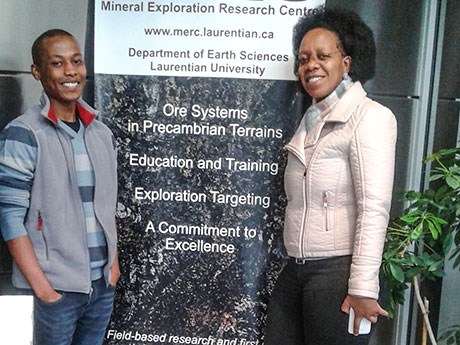Ivanhoe Mines turns to Sudbury to train South African geology students
Up to 50 Earth Science students at Laurentian University’s Goodman School of Mines and the University of Limpopo in South Africa will benefit from an academic co-operation and development initiative designed to educate South African geologists.
Ivanhoe Mines executive chairman Robert Friedland initiated the idea of a relationship between the two universities during a visit to Sudbury in 2013 as a guest lecturer.
“There are a lot of mining companies operating in South Africa’s Limpopo Province, but there are very few universities in the country with economic geology programs,” said Bruce Jago, executive director of the Goodman School of Mines. “Compared to the number of mines in the country, it’s very disproportionate to what’s needed.”
The co-operation agreement is part of Ivanhoe’s Social and Labour Plan to help South Africans benefit from its Platreef Project.
The University of Limpopo was founded as a Black university during the country’s Apartheid regime, noted Jago. “It didn’t have a lot of money and there wasn’t a real breadth of programming.”
Its Geology department has had its ups and downs over the years and is fairly small, he said.
“They don’t have a lot of lab space or equipment and the program is relatively restricted in terms of the courses it can offer. They have very few PhD level professors – mostly junior and senior level lecturers, typically Masters students, and they don’t have a graduate school.”
Ivanhoe Mines has allocated U.S. $1.4 million to cover the cost of academic exchanges between the two universities.
Two students from the University of Limpopo are currently working on a two-year Masters degree in Sudbury. Another six to eight students will arrive in September, to be followed by three more in January and another four or five in September 2017.
Some will complete a one-year Masters degree. Others will do a two-year Masters with a thesis. There will also be some PhD candidates and undergraduate students attending Laurentian for a semester.
Laurentian University students – primarily graduate students – will travel to South Africa to carry out research on South African deposits and provide teaching support at the University of Limpopo.
Soon after signing the MOU, Jago received a call from the International Development Research Council, a Canadian Crown corporation dedicated to helping developing countries.
“They asked us if we would like some additional money, so I put together an application and we were awarded $570,000,” said Jago.
At about the same time, two Laurentian University Earth Science professors received a Queen Elizabeth the Second Diamond Jubilee Scholarship in the amount of $500,000, “so we almost doubled Ivanhoe’s contribution with these two sources of funding.”
Ivanhoe’s 64 per cent owned Platreef Project in the Province of Limpopo includes the underground Flatreef deposit which boasts indicated mineral resources of 52.8 million ounces of platinum group elements and gold, and another 52.8 million ounces of inferred resources at a base cutoff grade of two grams per tonne. Shaft sinking, now underway, is scheduled to reach a depth of 777 metres by the third quarter of 2017.
A pre-feasibility study estimates annual production of 433,000 ounces of PGEs and gold, plus 19 million pounds of nickel and 12 million pounds of copper. The study estimates pre-production capital cost of $1.2 billion and a workforce of 2,200 within four years of the start of production.
In addition to the Platreef project, Ivanhoe also has two promising development projects in the Democratic Republic of the Congo – Kamoa, a 47 per cent-owned copper deposit, and Kipushi, a 68 per cent-owned zinc-copper project.
The Goodman School of Mines has also signed a memorandum of collaboration with the Groupement des professionnels des mines de Côte d’Ivoire and the Institut National Polytechnique Felix Houphouet-Boigny to help develop a qualified local workforce able to respond to the growing needs of that country’s mining industry.



